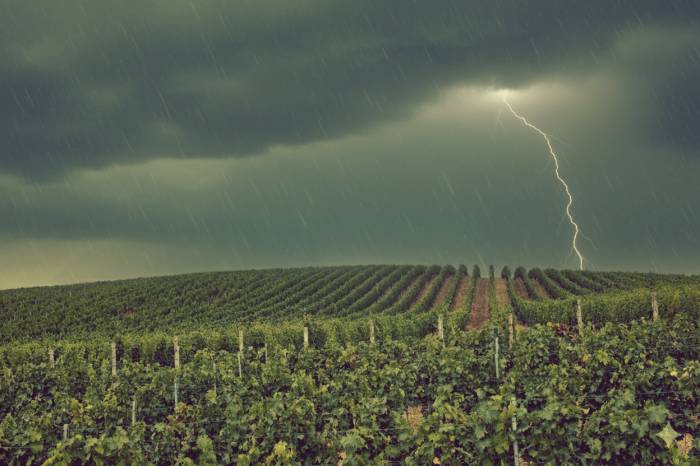Dry Lightning Storms Ignite Dozens of Wildfires Across California, Raising Alarm Over Future Fire Risks
Scientists warn climate change could bring more lightning-sparked blazes as detection and firefighting resources face mounting challenges
2025-09-08

A series of dry lightning storms swept across California last week, igniting dozens of wildfires and raising new concerns among scientists about the future of fire risk in the state. From early Tuesday into Wednesday morning, thousands of lightning bolts struck the ground, according to Cal Fire officials. In just over a day, 45 new fires started within Cal Fire’s jurisdiction. Many of these blazes are burning in the Sierra foothills, including the TCU September Lightning Complex in Tuolumne, Stanislaus and Calaveras Counties. These fires have already burned nearly 14,000 acres, forced evacuations, destroyed buildings and caused significant damage to the historic Gold Rush town of Chinese Camp.
Lightning strikes are not unusual in California, but the scale and intensity of last week’s storm were notable. Chris Vagasky, a lightning data specialist with the National Lightning Safety Council, estimated that nearly 11,000 bolts hit the ground in California over a 31-hour period. Federal maps show that dry lightning occurred up and down the center of the state, from south of Fresno to the Oregon border.
While most wildfires in California are started by people, lightning has been responsible for some of the largest and most destructive fires in recent history. According to John Abatzoglou, a climatology professor at UC Merced, lightning-caused fires have accounted for more than a third of the area burned in California over recent decades. The August Complex fire in 2020, which was started by lightning, became the first fire on record to burn more than a million acres in California.
A new study published last week in the journal Earth’s Future warns that climate change could bring even more lightning-sparked wildfires to the West in coming decades. The research team used machine learning to analyze future trends and found that from 2030 to 2060, some western states could see up to 12 additional days per year with lightning striking the ground. The largest increases are expected in eastern Oregon and Washington, Idaho and western Montana. Parts of northeast California and the eastern Sierra could also see more frequent lightning events.
The study’s lead author, Dmitri Kalashnikov, a postdoctoral scientist at UC Merced, explained that as climate change drives hotter and drier conditions across much of the West, lightning is increasingly likely to strike when vegetation is most vulnerable to fire. Dry lightning—lightning without significant rainfall—can ignite fires that smolder undetected for days before flaring up under hot and windy conditions.
Experts say that while some lightning-caused fires can act like prescribed burns by clearing away excess vegetation, problems arise when many fires start at once during a major storm. Zeke Lunder, a pyrogeographer who runs The Lookout wildfire education blog and YouTube channel, said that firefighting resources can be quickly overwhelmed when dozens or even hundreds of new fires ignite simultaneously.
Cal Fire battalion chief David Acuña described how unpredictable and dangerous these storms can be for firefighters on the ground. He recalled working on a lightning-sparked fire near Coalinga five years ago when another storm rolled through. With nowhere safe to shelter from the strikes, he and his crew lay flat on the ground until it passed.
Detecting these fires quickly is another challenge. Some can smolder inside tree roots or underground for more than a week before erupting into flames when conditions change. To improve detection efforts, Cal Fire has partnered with UC San Diego’s ALERTCalifornia program since 2023. This system uses more than 1,100 cameras and artificial intelligence to spot potential fires early and alert firefighters.
Scientists emphasize that while they have not yet observed a clear increase in lightning due to climate change, their models suggest it is coming soon. Kalashnikov said their predictions point to changes happening in the near-term future rather than decades away.
As California faces another intense fire season fueled by heat and drought, officials say they are maintaining high levels of readiness across the state. Acuña stressed that with little warning before last week’s storms arrived, rapid response remains critical to protecting people and property from these fast-moving threats.
Founded in 2007, Vinetur® is a registered trademark of VGSC S.L. with a long history in the wine industry.
VGSC, S.L. with VAT number B70255591 is a spanish company legally registered in the Commercial Register of the city of Santiago de Compostela, with registration number: Bulletin 181, Reference 356049 in Volume 13, Page 107, Section 6, Sheet 45028, Entry 2.
Email: [email protected]
Headquarters and offices located in Vilagarcia de Arousa, Spain.